Paleanthropology
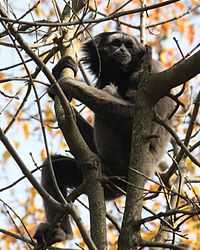
Paleanthropology, or paleoanthropolgy, is a branch of anthropology concerned with fossil hominids.
Anthropology
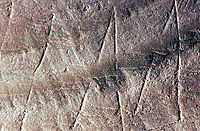
Def. "[t]he holistic scientific and social study of humanity, mainly using ethnography as its method"[1] is called anthropology.
"Anthropology is distinguished from other social science disciplines by its emphasis on in-depth examination of context, cross-cultural comparisons, and the importance it places on long-term, experiential immersion in the area of research."[1]
Theoretical paleanthropology
Def. the "scientific study of fossil humans, and the evolution of modern man"[2] is called paleanthropology.
Taxonomy
Def. an "ape of the family Hominidae, having a mostly hairless face, hands with complex fingerprints, and flat fingernails. Includes chimpanzees and gorillas (subfamily Homininae), and orangutans (subfamily Ponginae). Usage may vary to either include or exclude humans (members of Homininae subfamily)"[3] is called a great ape.
Def. any "great ape (including humans and apes) belonging to the superfamily Hominoidea"[4] is called a hominoid.
Classification:[5]
- Ordo: Primates
- Subordo: Haplorrhini
- Infraordo: Simiiformes
- Parvordo: Catarrhini
- Superfamilia: Hominoidea
- Familia: Hominidae
- Subfamilia: Homininae
- Tribus: Hominini
- Subtribus: Hominina
History

The graph above shows many of the hominins that have been discovered so far in Africa and elsewhere on Earth.
Paleogene
The Paleogene Period extends from 65.5 ± 0.3 to 23.03 ± 0.05 x 106 b2k.
Paleocene
The Paleocene dates from 65.5 ± 0.3 x 106 to 55.8 ± 0.2 x 106 b2k.
Plesiadapis
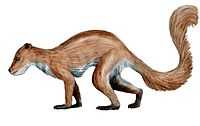
"Plesiadapis, the oldest known primate-like mammal, lived [58 million years ago.]"[6]
"Infants were fully formed but helpless, so mothers must have provided a great deal of care. Resembling squirrel-like lemurs, Plesiadapis moms also spent a lot of time scurrying around the ground and in trees."[6]
Eocene
The Eocene dates from 55.8 ± 0.2 x 106 to 33.9 ± 0.1 x 106 b2k.
Oligocene
The Oligocene dates from 33.9 ± 0.1 x 106 to 23.03 x 106 b2k.
Holarctic-Antarctic Ice Age
"This late Cenozoic ice age began at least 30 million years ago in Antarctica; it expanded to Arctic regions of southern Alaska, Greenland, Iceland, and Svalbard between 10 and 3 million years ago. Glaciers and ice sheets in these areas have been relatively stable, more-or-less permanent features during the past few million years."[7]
Rukwapithecus
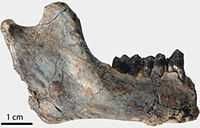
Rukwapithecus is "an early member of the hominoids, the group containing the great apes (gorillas, chimpanzees, bonobos, orangutans and humans) and lesser apes (gibbons)."[8]
"The fossil remnants ... date back 25 million years ago, filling a gap in the fossil record that reveals when apes and monkeys first diverged."[8]
"These discoveries are important because they offer the earliest fossil evidence for either of these primate groups".[9]
"The fossils were found in a layer of the Rukwa Rift in Tanzania. The region is part of the East African Rift, a tectonic-plate boundary where the Earth's crust is being pulled apart."[8]
“The new discoveries are particularly important for helping to reconcile a long-standing disagreement between divergence time estimates derived from analyses of DNA sequences from living primates and those suggested by the primate fossil record.”[10]
"Studies of clock-like mutations in primate DNA have indicated that the split between apes and Old World monkeys occurred between 30 million and 25 million years ago."[10]
Neogene
The Neogene dates from 23.03 x 106 to 2.58 x 106 b2k.
Miocene
The Miocene dates from 23.03 x 106 to 5.332 x 106 b2k.
Prehistory
The prehistory period dates from around 7 x 106 b2k to about 7,000 b2k.
Sahelanthropus tchadensis
"Sahelanthropus tchadensis is one of the oldest known species in the human family tree. This species lived sometime between 7 and 6 million years ago in West-Central Africa (Chad). Walking upright may have helped this species survive in diverse habitats, including forests and grasslands. Although we have only cranial material from Sahelanthropus, studies so far show this species had a combination of ape-like and human-like features. Ape-like features included a small brain (even slightly smaller than a chimpanzee’s), sloping face, very prominent browridges, and elongated skull. Human-like features included small canine teeth, a short middle part of the face, and a spinal cord opening underneath the skull instead of towards the back as seen in non-bipedal apes."[11]
"Some of the oldest evidence of a humanlike species moving about in an upright position comes from Sahelanthropus. The foramen magnum (the large opening where the spinal cord exits out of the cranium from the brain) is located further forward (on the underside of the cranium) than in apes or any other primate except humans. This feature indicates that the head of Sahelanthropus was held on an upright body, probably associated with walking on two legs."[11]
"The first (and, so far, only) fossils of Sahelanthropus are nine cranial specimens from northern Chad. A research team of scientists led by French paleontologist Michael Brunet uncovered the fossils in 2001, including the type specimen TM 266-01-0606-1. Before 2001, early humans in Africa had only been found in the Great Rift Valley in East Africa and sites in South Africa, so the discovery of Sahelanthropus fossils in West-Central Africa shows that the earliest humans were more widely distributed than previously thought."[11]
Orrorin tugenensis
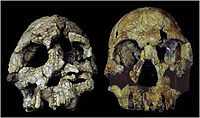
"Living around 6 million years ago, Orrorin tugenensis is the one of the oldest early humans on our family tree. Individuals of this species were approximately the size of a chimpanzee and had small teeth with thick enamel, similar to modern humans. The most important fossil of this species is an upper femur, showing evidence of bone buildup typical of a biped - so Orrorin tugenensis individuals climbed trees but also probably walked upright with two legs on the ground."[12]
"A research team led by French paleontologist Brigitte Senut and French geologist Martin Pickford discovered this species in the Tugen Hills region of central Kenya. They found more than a dozen early human fossils dating between about 6.2 million and 6.0 million years old. Because of its novel combination of ape and human traits, the researchers gave a new genus and species name to these fossils, Orrorin tugenensis, which in the local language means “original man in the Tugen region.” So far, Orrorin tugenensis is the only species in the genus Orrorin."[12]
"Orrorin’s femur (thigh bone) and humerus (upper arm bone) are about 1.5 times larger than those of Lucy’s (AL 288-1). Therefore, scientists estimate that Orrorin would have been 1.5 times larger than Au. afarensis, suggesting a size similar to a female chimpanzee, between about 30 and 50 kg."[12]
Ardipithecus kadabba
"Ardipithecus kadabba was bipedal (walked upright), probably similar in body and brain size to a modern chimpanzee, and had canines that resemble those in later hominins but that still project beyond the tooth row. This early human species is only known in the fossil record by a few post-cranial bones and sets of teeth. One bone from the large toe has a broad, robust appearance, suggesting its use in bipedal push-off."[13]
"When he found a piece of lower jaw lying on the ground in the Middle Awash region of Ethiopia 1997, paleoanthropologist Yohannes Haile-Selassie didn’t realize that he had uncovered a new species. But 11 specimens from at least 5 individuals later, Haile-Selassie was convinced he had found a new early human ancestor. The fossils—which also included hand and foot bones, partial arm bones, and a clavicle (collarbone)—were dated to 5.6–5.8 million years old. One of the specimens, a toe bone, is dated to 5.2 million years old; this fossil has features of bipedal walking. Faunal (fossil animal) evidence from the site indicated that the early humans there lived in a mixture of woodlands and grasslands, and had plenty of access to water via lakes and springs."[13]
"In 2002, six teeth were discovered in the Middle Awash at the site Asa Koma. The dental wear patterns confirmed the early human fossils were unique and not a subspecies of A. ramidus. Based on these teeth, paleoanthropologists Yohannes Haile-Selassie, Gen Suwa, and Tim White allocated the fossils in 2004 to a new species they named Ardipithecus kadabba (‘kadabba’ means ‘oldest ancestor’ in the Afar language)."[13]
Pliocene
The Pliocene ranges from 5.332 x 106 to 2.588 x 106 b2k.
Zanclean
"The boundary-stratotype of the stage is located in the Eraclea Minoa section on the southern coast of Sicily (Italy), at the base of the Trubi Formation. The age of the Zanclean and Pliocene GSSP at the base of the stage is 5.33 Ma in the orbitally calibrated time scale, and lies within the lowermost reversed episode of the Gilbert Chron (C3n.4r), below the Thvera normal subchron."[14]
Ardipithecus ramidus
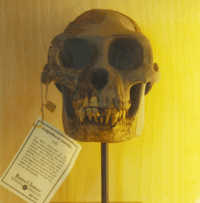
There "is 4.4-million-year-old Ardipithecus ramidus".[6]
"It is as close as we have ever come to finding the last common ancestor of chimpanzees and humans."[15]
Australopithecus anamensis
"Australopithecus anamensis has a combination of traits found in both apes and humans. The upper end of the tibia (shin bone) shows an expanded area of bone and a human-like orientation of the ankle joint, indicative of regular bipedal walking (support of body weight on one leg at the time). Long forearms and features of the wrist bones suggest these individuals probably climbed trees as well."[16]
"In 1965, a research team led by Bryan Patterson from Harvard University discovered a single arm bone (KNM-KP 271) of an early human at the site of Kanapoi in northern Kenya. But without additional human fossils, Patterson could not confidently identify the species to which it belonged. In 1994, a research team led by paleoanthropologist Meave Leakey found numerous teeth and fragments of bone at the same site. Leakey and her colleagues determined that the fossils were those of a very primitive hominin and they named a new species called Australopithecus anamensis (‘anam’ means ‘lake’ in the Turkana lanaguage). Researchers have since found other Au. anamensis fossils at nearby sites (including Allia Bay), all of which date between about 4.2 million and 3.9 million years old."[16]
"Australopithecus anamensis individuals had thickly-built, long, narrow jaws with their side rows of teeth arranged in parallel lines. Their strong jaws combined with heavily enameled teeth suggest Au. anamensis individuals may at times have eaten hard, abrasive foods, but they likely were plant-eaters in general, relying on both fruits and tough foods such as nuts. The sites where remains of Au. anamensis have been found were forests and woodlands that grew around lakes."[16]
"Jaw remains suggest that this species was the direct ancestor of Australopithecus afarensis, and possibly the direct descendent of a species of Ardipithecus."[16]
"A team led by Meave Leakey found the A. anamensis type specimen, mandible KNM-KP 29281, in Kenya in 1994. In 2006, Tim White’s team found A. anamensis fossils in the Middle Awash, Ethiopia, including the largest hominin canine yet discovered and the earliest Australopithecus femur."[16]
"This 4.1 million year old upper tibia (shin bone) fossil, KNM-KP 29285, comes from Australopithecus anamensis, an early human species that lived near open areas and dense woods. Their bodies had evolved in ways that enabled them to walk upright most of the time while still being able to climb trees. As a result, they could take advantage of both habitats. The top part of the tibia (where the lower leg meets the knee) is concave, or depressed from stress. This shows that the individual often put weight on the bone—evidence of standing upright. The lower part of the tibia (where the lower leg meets the ankle) is wider or thicker—evidence that it acted as a type of shock absorber as this individual walked ."[17]
Australopithecus afarensis
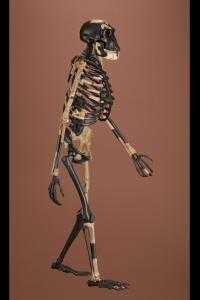
"Australopithecus afarensis is an extinct hominid that lived between 3.9 and 2.9 million years ago.[18]"[19]
"Among the earliest known relatives of humanity definitely known to walk upright was Australopithecus afarensis, the species including the famed 3.2-million-year-old "Lucy." [Found at Hadar, Ethiopia] Australopithecines are the leading candidates for direct ancestors of the human lineage, living about 2.9 million to 3.8 million years ago in East Africa."[20]
"Compared to the modern and extinct great apes, A. afarensis has reduced canines and molars, although they are still relatively larger than in modern humans. A. afarensis also has a relatively small brain size (~380–430 cm3) and a prognathic face (i.e. a face with forward projecting jaws)."[19]
""When looking at how we became human, an important moment in our history was abandoning a lifestyle in the trees, and when that happened is a big question."[21]
"Lucy's adult shoulder sockets also faced upward, suggesting that, like modern apes, her species was equipped for tree-climbing throughout its life span. Humans, on the other hand, are born with a somewhat downward-facing socket that gradually moves to face outward as people mature."[20]
"Her long arm bones [shown in the image on the right] and the crest created by muscles that attach to her humerus (upper arm bone) are evidence of a powerful chest and strong upper arm muscles necessary for tree climbing. Her short, broad pelvis also held her body upright while angled-in thigh bones kept her body weight directly above her knees while in stride, both requirements for walking efficiently on two legs. Lucy’s compact feet were capable of supporting her full body weight as she walked upright, but her long, curved toe bones resemble that of a tree-climbing ape. Because Lucy could walk upright on the ground and climb trees, she and other members of her species were able to use resources from woodlands, grasslands, and other diverse environments."[22]
Piacenzian
"The base of the beige marl bed of the small-scale carbonate cycle 77 (sensu Hilgen, 1991b) is the approved base of the Piacenzian Stage (that is the Lower Pliocene-Middle Pliocene boundary). It corresponds to precessional excursion 347 as numbered from the present with an astrochronological age estimate of 3.600 Ma (Lourens et al., 1996a)."[23]
Australopithecus deyiremeda
"A fossil find adds another twig to the human evolutionary tree, giving further evidence that the well-known “Lucy” species had company in what is now Ethiopia [...] A lower jaw, plus jaw fragments and teeth, dated at 3.3 million to 3.5 million years old, were found in the Afar region of northern Ethiopia four years ago."[24]
Australopithecus africanus
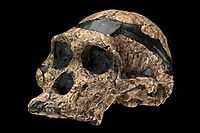
"Au. africanus was anatomically similar to Au. afarensis, with a combination of human-like and ape-like features. Compared to Au. afarensis, Au. africanus had a rounder cranium housing a larger brain and smaller teeth, but it also had some ape-like features including relatively long arms and a strongly sloping face that juts out from underneath the braincase with a pronounced jaw. Like Au. afarensis, the pelvis, femur (upper leg), and foot bones of Au. africanus indicate that it walked bipedally, but its shoulder and hand bones indicate they were also adapted for climbing."[25]
"The Taung child, found in 1924, was the first to establish that early fossil humans occurred in Africa. After Prof. Raymond Dart described it and named the species Australopithecus africanus (meaning southern ape of Africa), it took more than 20 years for the scientific community to widely accept Australopithecus as a member of the human family tree."[25]
"No stone tools have been discovered in the same sediments as Au. africanus fossils; however, for a long time researchers believed Au. africanus was a hunter. Raymond Dart created the term ‘osteodontokeratic’ culture (osteo = bone, donto = tooth, keratic = horn) in the 1940s and 1950s because remains of this species were found alongside broken animal bones. Dart assumed these broken animal bones, teeth and horns were used by Au. africanus as weapons; however, in the 1970s and 1980s, other scientists began to recognize that predators such as lions, leopards, and hyenas were instead responsible for leaving these broken animal bones. These predators even ate Au. africanus individuals, too."[25]
"Despite the carnivorous preferences of their contemporaneous predators, Au. africanus individuals had a diet similar to modern chimpanzees, which consisted of fruit, plants, nuts, seeds, roots, insects, and eggs."[25]
"Scientists can tell what Au. africanus may have eaten from looking at the remains of their teeth---tooth-size, shape, and tooth-wear can all provide diet clues. Dental microwear studies found more scratches than pits on Au. africanus teeth compared to a contemporaneous species, P. robustus. This pattern indicates that Au. africanus ate tough foods but also had a very variable diet including softer fruits and plants."[25]
Paranthropus aethiopicus
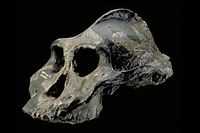
"Paranthropus aethiopicus is still much of a mystery to paleoanthropologists, as very few remains of this species have been found. The discovery of the 2.5 million year old ’Black Skull’ in 1985 helped define this species as the earliest known robust australopithecine. P. aethiopicus has a strongly protruding face, large megadont teeth, a powerful jaw, and a well-developed sagittal crest on top of skull, indicating huge chewing muscles, with a strong emphasis on the muscles that connected toward the back of the crest and created strong chewing forces on the front teeth."[26]
"Paranthropus aethiopicus was originally proposed in 1967 by a team of French paleontologists to describe a toothless partial mandible (Omo 18) that was thought to differ enough from the mandibles of the early human species known at that time. This naming of a new species was generally dismissed; many paleoanthropologists thought it premature to name a new species on the basis of a single incomplete mandible. In 1985, when Alan Walker and Richard Leakey discovered the famous "Black Skull" west of Lake Turkana in Kenya, the classification reemerged. With its mixture of derived and primitive traits, KNM-WT 17000 validated, in the eyes of many scientists, the recognition of a new "robust" australopithecine species dating to at least 2.5 million years ago in eastern Africa."[26]
"A massive humerus (upper arm bone) from East Turkana and an elongated ulna (one of the lower arm bones) from Omo may indicate a large forelimb and large body, but no post-cranial bones are securely ascribed to this species."[26]
"Many features of the skull are quite similar to Australopithecus afarensis, and P. aethiopicus may be a descendent of this species. It is most likely the ancestor of the robust australopithecine species found later in Eastern Africa, Paranthropus boisei."[26]
"The dark color comes from minerals in the soil that were absorbed by the skull as it fossilized. The front teeth fell out and the others were broken off after the individual died. This is the only known adult skull of this species, which is considered a direct ancestor of Paranthropus boisei."[26]
Paranthropus aethiopicus lived about 2.7 to 2.3 million years ago in Eastern Africa (Turkana basin of northern Kenya, southern Ethiopia).[26]
"This skull didn’t start out black – it was white, like all other bones in living animals. KNM-WT 17000 or the ’Black Skull’ only got its dramatic dark color after millions of years of sitting in a manganese-rich soil and absorbing minerals as it fossilized."[26]
"This nearly complete fossilized cranium has a face that projects far outward from the forehead, widely flaring zygomatic arches, and the largest sagittal crest of any early human. Though some of the individual’s front teeth fell out and others were broken off after death, molar and premolar roots in the jaw indicate that this early human would have also had massive cheek teeth; all of these features are adaptations for heavy chewing."[26]
"Because of the sagittal crest and the skull’s small cranial capacity (410cc), researchers originally classified the ’Black Skull’ as Paranthropus boisei - but further comparison showed more similarities to Australopithecus afarensis. This mosaic of features led scientists to assign the specimen to a new species: Paranthropus aethiopicus."[26]
The ’Black Skull’ is the only known adult skull of Paranthropus aethiopicus."[26]
Paleolithic
The paleolithic period dates from around 2.6 x 106 b2k to the end of the Pleistocene around 12,000 b2k.
Quaternary
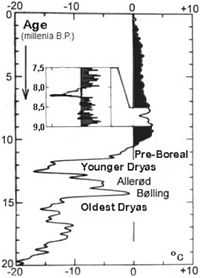
The "whole change elapsed just opposite the course of events that characterized the great glacial oscillations with sudden warming followed by slow cooling. Therefore, the two phenomena hardly have the same cause."[27]
Pleistocene
The Pleistocene dates from 2.588 x 106 to 11,700 b2k.
Gelasian
"The base of the Quaternary System is defined by the Global Stratotype Section and Point (GSSP) of the Gelasian Stage at Monte San Nicola in Sicily, Italy, currently dated at 2.58 Ma."[28]
Australopithecus garhi
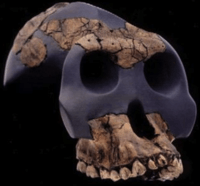
"This species is not well documented; it is defined on the basis of one fossil cranium and four other skull fragments, although a partial skeleton found nearby, from about the same layer, is usually included as part of the Australopithecus garhi sample. The associated fragmentary skeleton indicates a longer femur (compared to other Australopithecus specimens, like ‘Lucy’) even though long, powerful arms were maintained. This suggests a change toward longer strides during bipedal walking."[29]
"The human fossil record is poorly known between 3 million and 2 million years ago, which makes the finds from the site of Bouri, Middle Awash Ethiopia, particularly important. First in 1990 and then from 1996 to 1998, a research team led by Ethiopian paleoanthropologist Berhane Asfaw and American paleoanthropologist Tim White found the partial skull (BOU-VP-12/130) and other skeletal remains of an early humans dated to around 2.5 million years old. In 1997, the team named the new species Australopithecus garhi; the word ‘garhi’ means ‘surprise’ in the Afar language."[29]
"The principal specimen BOU-VP-12/1, a cranium, may be a male. It is similar in size to the average of other Australopithecus specimens."[29]
"Fossils of Australopithecus garhi are associated with some of the oldest known stone tools, along with animal bones that were cut and broken open with stone tools. It is possible, then, that this species was among the first to make the transition to stone toolmaking and to eating meat and bone marrow from large animals."[29]
The "partial cranium, designated as the species’ holotype, is actually a set of fragments consisting of the front and side portions of the skull, the upper jaw, and upper teeth. The lower face is prognathic and the back teeth are very large with thick enamel. The estimated cranial capacity from the reconstructed cranium is 450 cubic centimeters, similar to other australopithecines."[29]
Homo habilis
"[T]he hobbit [may have] evolved from Homo habilis, whose brains were only about 600 cubic cm (37 cubic inches)."[30]
From the geochronology under the history section, Homo habilis appeared about 2.5 x 106 b2k.
"The most comprehensive dataset ever assembled on our early human ancestors provides evidence that the first humans emerged in South Africa, and that the first humans to migrate out of Africa came from a small-bodied species such as Homo habilis, aka "Handy Man.""[31]
Traditionally, Handy Man "was viewed as a little human, with a relatively big brain, bipedalism, and tool-making forming part of the picture."[32]
"The study rejected the theory that Homo floresiensis individuals, "Hobbit Humans," were simply deformed members of our own species. The data instead shows that these tiny residents of the Island of Flores, Indonesia, did indeed belong to a unique species. Collard and his team suspect that the hobbits descended from a small-bodied early Homo species, such as Handy Man."[31]
"Following this theory, Handy Man gave rise to Upright Man in Asia."[31]
"Homo erectus would then have spread from Asia into Africa, rather than the reverse, which is what the current consensus contends."[32]
As for Neanderthals, "We're pretty sure that Neanderthals are an exclusively Eurasian species; there is no evidence for them in Africa."[32]
"The species that gave rise to Neanderthals remains a mystery for now. This puzzlement about them, and other Middle Pleistocene humans, is referred to as "the muddle in the middle."[32]"[31]
"The fact that Australopithecus sediba groups with Homo is consistent with the idea that the earliest known representative of the genus Homo originated in South Africa."[32]
Paranthropus boisei
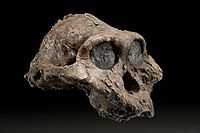
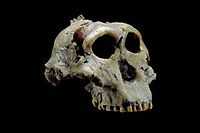
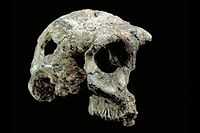
"Like other members of the Paranthropus genus, P. boisei is characterized by a specialized skull with adaptations for heavy chewing. A strong sagittal crest on the midline of the top of the skull anchored the temporalis muscles (large chewing muscles) from the top and side of the braincase to the lower jaw, and thus moved the massive jaw up and down. The force was focused on the large cheek teeth (molars and premolars). Flaring cheekbones gave P. boisei a very wide and dish-shaped face, creating a larger opening for bigger jaw muscles to pass through and support massive cheek teeth four times the size of a modern human’s. This species had even larger cheek teeth than P. robustus, a flatter, bigger-brained skull than P. aethiopicus, and the thickest dental enamel of any known early human. Cranial capacity in this species suggests a slight rise in brain size (about 100 cc in 1 million years) independent of brain enlargement in the genus Homo."[33]
"Paleoanthropologists actually found the first fossils belonging to P. boisei in 1955, but it wasn’t until Mary Leakey’s 1959 discovery of the ‘Zinj’ skull (OH 5) that scientists knew what they had found was a new species. ‘Zinj’ became the type specimen for P. boisei and, soon after, arguably the most famous early human fossil from Olduvai Gorge in northern Tanzania."[33]
"If you compare a male P. boisei individual to a male Au. africanus who lived during a similar time period (3.3–2.1 Mya), you’ll see why the species Paranthropus got the name ‘robust.’ While both males are on average 4 ft 6 inches tall, the average male P. boisei was 18 pounds heavier than a male Au. africanus of the same height. Even P. boisei females were slightly larger and heavier than what scientists had seen before in the fossil record of other early humans."[33]
"Male and female P. boisei individuals were closer in body size than individuals of other species of early humans preceding them, but this species still had a fairly high level of sexual dimorphism."[33]
"This species was nicknamed Nutcracker Man for its big teeth and strong chewing muscles, which attached to the large crest on the skull. Those features show that Paranthropus boisei likely ate tough foods like roots and nuts. But dental microwear patterns seen on P. boisei teeth are more similar to living fruit-eaters with fine striations, rather than large, deep pits seen in the teeth of living species that eat grass, tough leaves and stems, or other hard, brittle foods. While the morphology of P. boisei skull and teeth indicate it could have chewed hard or tough foods, dental microwear analysis does not demonstrate that they regularly did so, suggesting a wider, more diverse diet for P. boisei. It's possible that this species only ate hard or tough foods during times when its preferred resources were scarce, relying on them as fallback foods."[33]
"P. boisei is usually thought to descend from earlier P. aethiopicus (who inhabited the same geographic area just a few hundred thousand years before) and lived alongside several other species of early humans during its 1.1 million year existence. P. boisei belongs to just one of the many side branches of human evolution, which most scientists agree includes all Paranthropus species and did not lead to H. sapiens."[33]
"The 1975 discovery of P. boisei specimen KNM-ER 406 and H. erectus specimen KNM-ER 3733 in the same stratigraphic layer was the first example of species coexistence. This discovery cleared up a long time controversy and confirmed that more than one species of early humans lived in the same geographical area at the same time. More finds have confirmed that this species was one of the most prevalent in Eastern Africa during the time period when early members of the genus Homo were also present. This replaced the traditional view of a single human lineage by the notion of a human family tree with many branches (like most other family trees); we’ve been adding branches though discoveries of new species ever since."[33]
"KNM-ER 732 [second image down on the right], a partial cranium of a female Paranthropus boisei has many characteristic P. boisei features. Most notable is the forward placed root of the zygomatic arch, resulting in a wide flat face. This skull has a cranial capacity of 500 cubic centimeters, nearly identical to the 510 cubic centimeters of presumed male P. boisei KNM-ER 406. Yet the skull shows less robust facial features than KNM-ER 406; the face is less massive overall, and it lacks a sagittal crest. From this, scientists conclude that KNM-ER 732 represents a female of the Parathropus boisei species. This fossil provides clues as to the nature of sexual dimorphism in this early human species."[33]
"Olduvai Hominid 5 (OH 5 [first image on the left]) is easily the most famous of the early human fossils found at Olduvai Gorge. It is a nearly complete cranium of an adult male P. boisei. Originally named Zinjanthropus boisei, its classification was changed to Australopithecus boisei and later Paranthropus boisei, placing it in the same genus as the southern African species."[34]
"The South African species Paranthropus robustus provided the original standard for the robust cranial form: a large sagittal crest on the top of the skull, a flat face formed by large zygomatic arches positioned far forward and megadont cheek teeth. But with the discovery of "Zinj" in eastern Africa, a new level of robusticity was defined, sometimes called "hyper-robust". Notice the wide zygomatic arches which project forward of the nasal opening and form the dished-shape face typical of Paranthropus boisei. The outward flaring of these bony arches from the side of the head provided space for large temporalis muscles. These were the huge chewing muscles that passed from the lower jaw to the large sagittal crest atop the skull. In some cases, the megadont cheek teeth of Paranthropus boisei were four times the size of our own."[34]
The "Zinj" fossil is about 1.8 million years old.[34]
Australopithecus sediba
"A 2 million-year-old ancestor of man had a mixture of ape and human-like features that allowed it to hike vast distances on two legs with as much ease as it could scurry up trees ... Discovered in cave near Johannesburg in 2008, the fossils of a species named Australopithecus sediba ... Standing about 1.3 meters (4 ft) tall, sediba had a narrow rib cage similar to apes but a flexible spine more similar to that of a human. Its long arms and powerful torso helped in climbing ... Sediba's small heel resembled a chimpanzee's and it walked with an inward rotation of the knee and hip on slightly twisted feet with a flat-footed gait that would have helped it cover ground".[35]
"It is the perfect compromise of something that has the need to walk on the ground efficiently for long distances. At the same time, it is a very capable climber".[36]
"The teeth also show a mix of human and primitive features, and provide new evidence that A. sediba is closely related to early humans ... It and an older South African species, A. africanus, appear more closely related to early humans than other australopithecines like the famous "Lucy" are".[37]
"Its scapula or shoulder blade is most similar in shape to that of orangutans, the most arboreal or tree-dwelling of all the apes ... This suggests climbing was still an important part of its behavior and ecology. ... They're still capable of very powerful grips, which is what you'd need if you were climbing or suspended under a branch ... It looks like a hand good for both tools and climbing."[38]
"The extinct species' teeth are a combination of primitive and humanlike traits. Their features suggest Au. sediba was a close relative of another southern African australopith known as Australopithecus africanus."[39]
"Au. sediba stood a little more than 4 feet high (1.2 meters). Analysis of its spine revealed it had a humanlike curvature of the lower back. However, its lower back was longer and more flexible than modern humans, and more like primitive, extinct members of Homo."[39]
"The broad thorax we have is unique to humans — the only mammal that doesn't have narrowing at the shoulders is humans ... We can lift our thorax to breathe, change the capacity for respiration, which is one of the main reasons humans are good long-distance runners. Chimpanzees don't have that."[40]
Calabrian
"The [Calabrian] GSSP occurs at the base of the marine claystone conformably overlying sapropelic bed ‘e’ within Segment B in the Vrica section. This lithological level represents the primary marker for the recognition of the boundary, and is assigned an astronomical age of 1.80 Ma on the basis of sapropel calibration."[41]
Paranthropus robustus
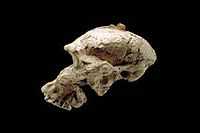
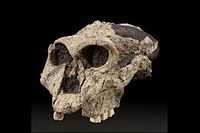
"Paranthropus robustus is an example of a robust australopithecine; they had very large megadont cheek teeth with thick enamel and focused their chewing in the back of the jaw. Large zygomatic arches (cheek bones) allowed the passage of large chewing muscles to the jaw and gave P. robustus individuals their characteristically wide, dish-shaped face. A large sagittal crest provided a large area to anchor these chewing muscles to the skull. These adaptations provided P. robustus with the ability of grinding down tough, fibrous foods. It is now known that ‘robust’ refers solely to tooth and face size, not to the body size of P. robustus."[42]
"When scientist Robert Broom bought a fossil jaw fragment and molar in 1938 that didn’t look anything like some of the Au. africanus fossils he’d found during his career, he knew he was on to something different. After exploring Kromdraai, South Africa, the site where the curious fossils came from, Broom collected many more bones and teeth that together convinced him he had a new species which he named Paranthropus robustus (Paranthropus meaning “beside man”)."[42]
"Robust species like Paranthropus robustus had large teeth as well as a ridge on top of the skull, where strong chewing muscles attached. These features allowed individuals to crush and grind hard foods such as nuts, seeds, roots, and tubers in the back of the jaw; however, P. robustus didn’t just eat tough foods. This early human species may have been more of a dietary generalist, also eating variety of other foods such as soft fruits and possibly young leaves, insects, and meat."[42]
"While scientists have not found any stone tools associated with Paranthropus robustus fossils, experiments and microscopic studies of bone fragments show that these early humans probably used bones as tools to dig in termite mounds. Through repeated use, the ends of these tools became rounded and polished. Termites are rich in protein, and would have been a nutritious source of food for Paranthropus."[42]
"From 1940s through 1970s, lots of debate whether this species represented the males of Au. africanus. Eventually, scientists recognized that the 'robust' forms were different enough to be in their own species, originally called Australopithecus robustus. Later, the three robust species (aethiopicus, boisei, and robustus) were recognized as being different enough from the other australopithecines - and similar enough to each other - to be placed into a separate genus, Paranthropus."[42]
"SK 46 [image on the right] preserves the left half of the braincase and the nearly complete palate of Paranthropus robustus. The cheek teeth are nearly perfectly preserved; although the incisors and one canine tooth have been lost, their alveoli (the bony pits that hold the tooth roots) remain. Because these alveoli are still preserved, paleoanthropologists are able to reconstruct the size of the cheek teeth (molars and premolars) relative to the incisors and canines. This information can give clues about the dietary habits of this early human species. The large size of the cheek teeth relative to the front teeth suggests that Paranthropus robustus had a diet dominated by coarse vegetable matter. The large teeth provided a large occlusal area (the area where the upper and lower teeth contact each other during chewing). Think about a cow, or a horse, both of which eat large amounts of grass and other coarse plant foods. These animals have large cheek teeth and large chewing surfaces. By this kind of analogy and by direct study of microscopic wear on the tooth surfaces, scientists have determined that the large cheek teeth of robust australopiths were used for grinding tough, fibrous foods."[42]
"The preserved portion of the cranium has other features typical of P. robustus, including large zygomatic arches and a prominent sagittal crest. These features are associated with large chewing muscles used in grinding tough foods."[42]
Paranthropus robustus is between 1.8 and 1.5 million years old.[42]
"Discovered in the debris pile at a cave site commercially mined for calcite, this skull [second down on the right] represented until recently the best preserved skull of any member of this species. SK 48 is the cranium of an adult robust australopith. Most of the skull (minus the lower jaw) is preserved and is relatively undistorted by the fossilization process, although some damage did occur when the specimen was dynamited out of the limestone deposits by miners. Preserved in the cranium were the right canine tooth and first premolar and all three left molars, indicating the individual was an adult at death."[42]
"The flat face, caused by the anterior (frontward) position of the cheekbones, and the extremely large molars and premolars are typical traits of robust australopithecines. These traits are linked to the development of a chewing complex designed to process tough, fibrous foods. The anterior position of the cheekbones created more space for large chewing muscles to pass behind the zygomatic arch. The large molars and premolars provided large surfaces for grinding tough foods."[42]
"The fossil was originally described by Robert Broom of the Transvaal Museum of South Africa. He inferred that the individual was a female based on the presence of a very small sagittal crest."[42]
Homo rudolfensis
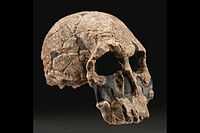
"There is only one really good fossil of this Homo rudolfensis: KNM-ER 1470, from Koobi Fora in the Lake Turkana basin, Kenya. It has one really critical feature: a braincase size of 775 cubic centimeters, which is considerably above the upper end of H. habilis braincase size. At least one other braincase from the same region also shows such a large cranial capacity."[43]
"Originally considered to be H. habilis, the ways in which H. rudolfensis differs is in its larger braincase, longer face, and larger molar and premolar teeth. Due to the last two features, though, some scientists still wonder whether this species might better be considered an Australopithecus, although one with a large brain!"[43]
"Russian scientist V.P. Alexeev named the species in 1986 after Richard Leakey’s team uncovered Homo rudolfensis fossils near the shores of Lake Rudolf (now known as Lake Turkana) in 1972. Alexeev originally named the species Pithecanthropus rudolfensis, but the genus name Pithecanthropus was later replaced by Homo."[43]
"Homo rudolfensis had large and wider molars compared to Homo habilis. While their teeth were only slightly smaller than those seen in robust australopithecines, H. rudolfensis didn’t have the heavily-built jaw and strong jaw muscle attachments seen in robust early humans. These anatomical differences likely indicate different diets between H. rudolfensis and earlier australopith species capable of more powerful chewing."[43]
"Like other early Homo species, Homo rudolfensis may have used stone tools [to] process their food. However, because more than one species of early human lived at the time tool manufacture and use originated, it’s hard for scientists to be certain which species is responsible for the making and using the first stone tools. There are currently no stone tools found in the same layers as the H. rudolfensis fossils, but there are stone tools existing in the same time period that H. rudolfensis lived."[43]
Most "scientists recognize four species that lived in the Turkana Basin, northern Kenya, sometime between 2.0 and 1.5 million years ago: Homo rudolfensis, Homo habilis, Homo erectus, and Paranthropus boisei."[43]
"Over several weeks following its discovery, scientists Meave Leakey and Bernard Wood reconstructed KNM-ER 1470’s skull from more than 150 fragments, revealing a large cranium with a long, wide, flat face. While tooth roots show that this early human had large teeth, the skull lacked the massive jaw muscle features characteristic of robust australopithecines."[43]
The fragments were discovered by Bernard Ngeneo.[43]
Homo antecessor
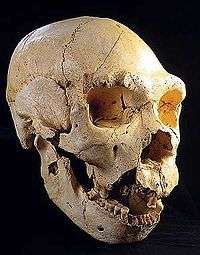
"Homo antecessor, an early member of our genus from Europe, lived 1.2 million years ago."[6]
On the right is one of five skulls unearthed in Europe. This particular one is from the Burgos dated to about 800,000 b2k.
Aftonian
"Clay deposition in the Piauí River floodplain around 436 ± 51.5 ka occurred during a warmer period of the Aftonian interglaciation, corresponding to isotope stage 12 (Ericson and Wollin, 1968)."[44]
Eemian interglacial
The "controversially split Eemian period, the predecessor of our own warm period about 125,000 years ago."[27]
"The Eem interglaciation […] lasted from 131 to 117 kyr B.P."[27]
Brørup interstadial
The "Brørup interstade [is about] 100 ka BP".[45] It corresponds to GIS 23/24.[46]
Odderade interstadial
The Odderade interstadial has a 14C date of 61-72 kyr B.P. and corresponds to GIS 21.[46]
Karmøy stadial
The Karmøy stadial begins in the high mountains of Norway about 60 kyr B.P. and expands to the outer coast by 58 kyr B.P.[46]
Oerel interstadial
The Oerel interstadial has a 14C date of 53-58 kyr B.P. and corresponds to GIS 15/16 with a GIS age of 56-59 kyr B.P.[46]
Likely stadial
"Genetics suggests Neanderthal numbers dropped sharply around 50,000 years ago. This coincides with a sudden cold snap, hinting climate struck the first blow."[47]
Glinde interstadial
The Glinde interstadial has a 14C date of 48-50 kyr B.P. and corresponds to GIS ?13/14 with a GIS age of 49-54.5 kyr B.P.[46]
Moershoofd interstadial
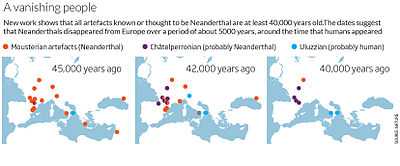
The Moershoofd interstadial has a 14C date of 44-46 kyr B.P. and corresponds to GIS 12 at 45-47 kyr B.P.[46]
Hasselo stadial
The "Hasselo stadial [is] at approximately 40-38,500 14C years B.P. (Van Huissteden, 1990)."[48]
The "Hasselo Stadial [is a glacial advance] (44–39 ka ago)".[49]
Hengelo interstadial
The Hengelo interstadial [is] > 35 ka BP".[45]
The "Hengelo Interstadial [is] (38–36 ka ago)."[49]
Huneborg interstadial
The Huneborg interstadial is a Greenland interstadial dating 36.5-38.5 kyr B.P. GIS 8.[46]
Ålesund Interstadial
The Ålesund interstadial began with GIS 6 and ended after GIS 8.[46]
GIS 5
GIS 5 interstadial occurred during the Klintholm advance about 33.5 kyr B.P.[46]
"The archeological evidence of human residence on [the Japanese] Archipelago goes back to >30 000 years [30,000 b2k] Recent admixture with the Mainland Japanese was observed for more than one third of the Ainu individuals [...] The Ainu population seems to have experienced admixture with another population [...] The Ainu and the Ryukyuan are tightly clustered [...] the origins of the Jomon and the Yayoi people still remain to be solved."[50]
Klintholm advance
This advance occurred after the Møn and ended with GIS 6.[46]
Møn interstadial
The Møn interstadial corresponds to GIS 4.[46]
GIS 3
The stronger GIS 3 interstadial occurred about 27.6 kyr B.P.[46]
GIS 2
The weak interstadial corresponding to GIS 2 occurred about 23.2 kyr B.P.[46]
Jylland stade
"After c. 22 ka BP [which is] during the Jylland stade (Houmark-Nielsen 1989)".[45]
Oldest Dryas
"During the Late Weichselian glacial maximum (20-15 ka BP) the overriding of ice streams eventually lead to strong glaciotectonic displacement of Late Pleistocene and pre-Quaternary deposits and to deposition of till."[45]
Bølling Oscillation
The "intra-Bølling cold period [IBCP is a century-scale cold event and the] Bølling warming [occurs] at 14600 cal [calendar years, ~ b2k] BP (12700 14C BP)".[51]
Older Dryas
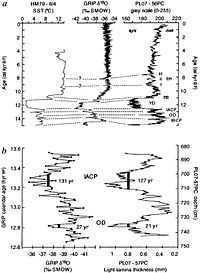
"Older Dryas [...] events [occurred about 13,400 b2k]".[52]
Mesolithic
The mesolithic period dates from around 13,000 to 8,500 b2k.
Neolithic
The base of the Neolithic is approximated to 12,200 b2k.
Allerød Oscillation
The "Allerød Chronozone, 11,800 to 11,000 years ago".[53]
Holocene
The Holocene starts at ~11,700 b2k and extends to the present.
Younger Dryas
The "Alleröd/Younger Dryas transition [occurred] some 11,000 years ago [11,000 b2k]."[53]
Pre-Boreal transition
The last glaciation appears to have a gradual decline ending about 12,000 b2k. This may have been the end of the Pre-Boreal transition.
"About 9000 years ago the temperature in Greenland culminated at 4°C warmer than today. Since then it has become slowly cooler with only one dramatic change of climate. This happened 8250 years ago [...]. In an otherwise warm period the temperature fell 7°C within a decade, and it took 300 years to re-establish the warm climate. This event has also been demonstrated in European wooden ring series and in European bogs."[27]
"The last remains of the American ice sheet disappeared about 6000 years ago [6,000 b2k], the Scandinavian one 2000 years earlier [8,000 b2k]."[27]
Ancient history
The ancient history period dates from around 8,000 to 3,000 b2k.
Atlantic history
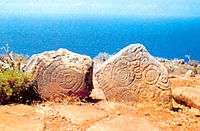
The "Atlantic period [is] 4.6–6 ka [4,600-6,000 b2k]."[54]
The petroglyph on the right contains spirals way over to the right in the image. This petroglyph is IV-II millemium BCE and shows a cup-and-ring mark and deer hunting scenes.
These petroglyphs from Galicia look like the petroglyphs from the Canary Islands shown on the left.
Early history
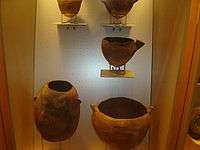
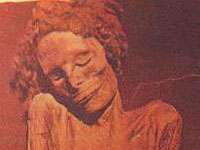
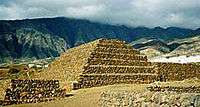
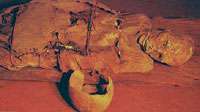
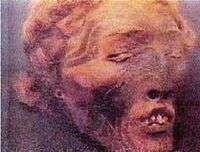
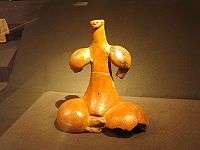
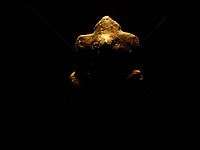
The early history period dates from around 3,000 to 2,000 b2k.
The Guanches are believed to be the original inhabitants of the Canary Islands perhaps as early as 3,000 b2k.
The first image on the right shows examples of Guanches pottery.
The second image down on the right is one of the Pyramids of Guimar, Canary Islands.
The "Guanches built several small step pyramids on the islands, using the same model as those found in ancient Egypt and in Mesopotamia."[55]
"The pyramids have an east-west alignment which also indicates that they probably had a religious [or astronomical] purpose, associated with the rise and setting of the sun."[55]
"Carefully built stairways on the west side of each pyramid lead up to the summit, which in each case has a flat platform covered with gravel, possibly used for religious or ceremonial purposes."[55]
They "shared a number of cultural characteristics with the ancient Egyptians and [...] their building style appears to have been replicated in South and Central America."[55]
The mummies on the left have red hair, the third down has blonde, and other Nordic features of the original inhabitants of the Canary Islands.
"An examination of one of the mummies' bodies showed incisions that virtually matched those found in Egyptian mummies, although the string used by the Guanche embalmers to close the wounds was much coarser than would have been used by the Egyptian experts."[55]
"Like the Celtic Tocharians, the finest evidence of what the original Guanche looked like, is in the fortuitous existence of original Guanche mummies, which are on public display in that island group's national museum."[55]
"As the original inhabitants of the Canary Islands were fair-haired and bearded, it was possible [...] that long before the 15th Century, people of the same stock as those who settled the Canary Islands, also sailed the same route along the Canary Current that took Christopher Columbus to the Americas."[56]
"According to the Aztec and Olmec (Central American Amerind) legends, their god, Quetzalcoatl, had Nordic features (eyes and hair color) and a beard. This god came from over the sea and taught the Amerinds how to raise corn and build structures."[55]
"The existence of the red-haired Guanches on the Canary Islands, combined with the red-haired pre-Columbus mummies found in South America and the marked similarity in pyramid building styles, indicate that an over the atlantic people probably used the Canaries Current to cross the Atlantic, most likely between 2000 and 500 BC."[55]
"The original occupants of the Canary Islands were a native people called the Guanche. Their mummies have been found with red hair and blond hair. Reportedly, the men were around 7 feet and the women around 6 feet."[57]
"Generally dolichocephalic, fair-featured with blond or red-hair, with males over six foot tall and women approaching six feet in height, they were a people of tall, strong and comely appearance, resembling many Northern Europeans today but for a generally greater and more robust stature. Their general appearance and racial characteristic were valued by the Spanish: "All historians agree in reporting that the Canarians were beautiful. They were tall, well built and of singular proportion. They were also robust and courageous with high mental capacity. Women were very beautiful and Spanish Gentlemen often used to take their wives among the population.""[58]
The third image down on the right is a statue made by an unknown Guanches, as is the fourth image down on the right. It is apparently of an entity called Guatimac.
Subboreal history
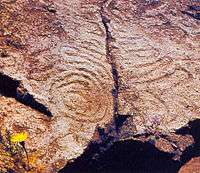
The "period around 850-760 BC [2850-2760 b2k], characterised by a decrease in solar activity and a sharp increase of Δ 14C [...] the local vegetation succession, in relation to the changes in atmospheric radiocarbon content, shows additional evidence for solar forcing of climate change at the Subboreal - Subatlantic transition."[59]
The "Holocene climatic optimum in this interior part of Asia [Lake Baikal] corresponds to the Subboreal period 2.5–4.5 ka".[54]
Although the spirals in the image on the right are undated, they may have been made as early as the Subboreal. These spirals on the Canary Islands are similar to ones found in Galicia, which is north of Portugal.
Subatlantic history
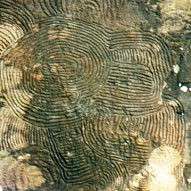
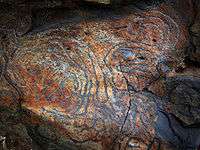
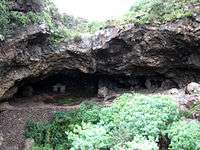
The "calibration of radiocarbon dates at approximately 2500-2450 BP [2500-2450 b2k] is problematic due to a "plateau" (known as the "Hallstatt-plateau") in the calibration curve [...] A decrease in solar activity caused an increase in production of 14C, and thus a sharp rise in Δ 14C, beginning at approximately 850 cal (calendar years) BC [...] Between approximately 760 and 420 cal BC (corresponding to 2500-2425 BP [2500-2425 b2k]), the concentration of 14C returned to "normal" values."[59]
The petroglyphs in the image on the right have not been dated, but could be from the subatlantic period.
A more varied set of petroglyphs in the second image on the right is in the Cave of Belmaco. The entrance to which is shown on the left.
Classical history
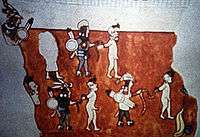
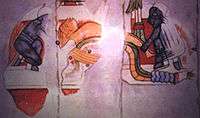
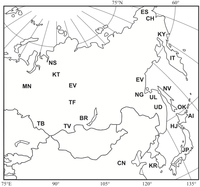
The classical history period dates from around 2,000 to 1,000 b2k.
On the right are "pre-Columbian wall paintings which can be found in the Temple of the Warriors, Chichen Itza, on the east coast of Mexico. The first [on the right] depicts prisoners after their capture by the dark-skinned natives, and the second [down on the right], shows a man with long blond hair being sacrificed."[55]
The map on the left shows the current geographical locations of anthropological remains from various northeastern populations of OK, Okhotsk; UL, Ulichi; NV, Nivkhi; NG, Negidal; AI, Ainu; HJ, Hokkaido Jomon; JP, Mainland Japanese; CN, Chinese; KR, Korean; UD, Udegey; KY, Koryak; IT, Itelmen; ES, Eskimo; CH, Chukuchi; EV, Evenki; BR, Buryat; TF, Tofalar; TV, Tuvan; TB, Tubalar; NS, Nganasan; KT, Ket; MN, Mansi.
"The Okhotsk culture developed around the southern coastal regions of the Okhotsk Sea during the 5th–13th centuries (Amano, 2003a)."[60]
"The Okhotsk culture differs in certain respects from the Epi-Jomon culture (3rd century BC–7th century AD) and the Satsumon culture (8th–14th centuries: Amano, 2003b), which were contemporary with the Okhotsk culture and developed in the southern and inner parts of Hokkaido Island."[60]
The "Okhotsk people [may have] merged with the Satsumon people (a direct ancestoral lineage of the Ainu people) on Hokkaido, resulting in the establishment of the Ainu people (Utagawa, 2002)."[60]
The "Okhotsk people were closely related to the Ulchi, Ainu, and Negidal."[60]
The "Koryak are closely related to the Okhotsk people [...]."[60]
Recent history
The recent history period dates from around 1,000 b2k to present.
Little Ice Age
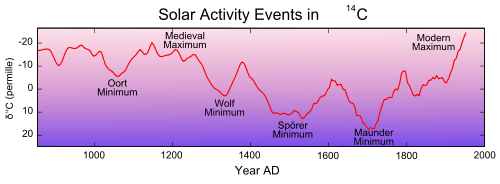
The Little Ice Age (LIA) appears to have lasted from about 1218 (782 b2k) to about 1878 (122 b2k).
Guanches in 1496
The image on the right hangs in the interior of the ayuntamiento of San Cristobal de La Laguna, Tenerife.
The painting on the right shows the surrender of the Guanches kings of Tenerife to Ferdinand and Isabella. This appears to have occurred c. 504 b2k.
The painting on the left was painted in 1764. It depicts the surrender of the Guanches leaders Bencomo mencey with Tacoronte, Anaga and Tegueste to Governor Alonso Fernández de Lugo with his captains and noble friends, by bringing gifts to the governor.
Ainu in 1860s
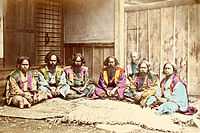
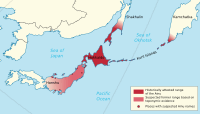
The Ainu are a people inhabiting the Northern island of Yesso. They differ from the Japanese in language and race. Their origin is lost in a wild and fabulous tradition. The legend runs thus—“That the race owes its preservation to a doll which swam across from Corea to the uninhabited island of Yesso.” They were conquered some three hundred years ago by the Japanese.
The colorized photograph on the right is from between 1863 and 1870 (137-130 b2k).
The map shows their widest expanse historically.
Research
Hypothesis:
- Hominoids with brain sizes larger than a gorilla may have been driven to extinction by Homo sapiens.
- Hominins includes any primate that walks upright.
Control groups

The findings demonstrate a statistically systematic change from the status quo or the control group.
“In the design of experiments, treatments [or special properties or characteristics] are applied to [or observed in] experimental units in the treatment group(s).[61] In comparative experiments, members of the complementary group, the control group, receive either no treatment or a standard treatment.[62]"[63]
Proof of concept
Def. a “short and/or incomplete realization of a certain method or idea to demonstrate its feasibility"[64] is called a proof of concept.
Def. evidence that demonstrates that a concept is possible is called proof of concept.
The proof-of-concept structure consists of
- background,
- procedures,
- findings, and
- interpretation.[65]
See also
References
- 1 2 "anthropology, In: Wiktionary". San Francisco, California: Wikimedia Foundation, Inc. 27 January 2013. Retrieved 2013-01-27.
- ↑ Romanophile (6 May 2011). "paleanthropology, In: Wiktionary". San Francisco, California: Wikimedia Foundation, Inc. Retrieved 2015-06-07.
- ↑ "great ape, In: Wiktionary". San Francisco, California: Wikimedia Foundation, Inc. 16 December 2014. Retrieved 2015-06-07.
- ↑ "hominoid, In: Wiktionary". San Francisco, California: Wikimedia Foundation, Inc. 17 October 2014. Retrieved 2015-06-07.
- ↑ "Paranthropus, In: Wikispecies". San Francisco, California: Wikimedia Foundation, Inc. 19 January 2013. Retrieved 2015-06-08.
- 1 2 3 4 Jennifer Viegas (10 May 2013). "Prehistoric Moms Had Their Hands Full: Photos". Discovery.com. Retrieved 2014-12-07.
- ↑ James S. Aber (2008). "GLACIATIONS THROUGHOUT EARTH HISTORY". Emporia, Kansas USA: Emporia State University. Retrieved 2014-11-06.
- 1 2 3 Tanya Lewis (May 15, 2013). "Oldest Fossils Reveal When Apes & Monkeys First Diverged". Yahoo! News. Retrieved 2013-05-28.
- ↑ Nancy Stevens (May 15, 2013). "Oldest Fossils Reveal When Apes & Monkeys First Diverged". Yahoo! News. Retrieved 2013-05-28.
- 1 2 Nancy J. Stevens (16 May 2013). "25-Million-Year-Old Primate Fossils Unearthed in Tanzania". Science News. Retrieved 2015-06-08.
- 1 2 3 Michael Brunet (26 May 2015). "Sahelanthropus tchadensis". Washington, DC USA: Smithsonian Institution. Retrieved 2015-05-31.
- 1 2 3 Brigitte Senut and Martin Pickford (26 May 2015). "Orrorin tugenensis". Washington, DC USA: Smithsonian Institution. Retrieved 2015-05-31.
- 1 2 3 Yohannes Haile-Selassie (26 May 2015). "Ardipithecus kadabba". Washington, DC USA: Smithsonian Institution. Retrieved 2015-05-30.
- ↑ John A. Van Couvering, Davide Castradori, Maria Bianca Cita, Frederik J. Hilgen, and Domenico Rio (September 2000). [http://www.stratigraphy.org/GSSP/Zanclean.pdf "The base of the Zanclean Stage and of the Pliocene Series"]. Episodes 23 (3): 179-87. http://www.stratigraphy.org/GSSP/Zanclean.pdf. Retrieved 2015-01-23.
- ↑ Jay Matternes (10 May 2013). "Prehistoric Moms Had Their Hands Full: Photos". Discovery.com. Retrieved 2014-12-07.
- 1 2 3 4 5 Meave Leakey (03 June 2015). "Australopithecus anamensis". Washinton, DC USA: Smithsonian Institution. Retrieved 2015-06-03.
- ↑ Kamoya Kimeu (03 June 2015). "Australopithecus anamensis". Washinton, DC USA: Smithsonian Institution. Retrieved 2015-06-03.
- ↑ William A. Haviland, Harald E. L. Prins,Dana Walrath,Bunny McBride. Evolution And Prehistory: The Human Challenge. http://books.google.ro/books?id=LfYirloa_rUC&pg=PA134&lpg=PA134&f=false.
- 1 2 "Australopithecus afarensis, In: Wikipedia". San Francisco, California: Wikimedia Foundation, Inc. October 26, 2012. Retrieved 2012-10-28.
- 1 2 Charles Choi (October 25, 2012). Early Human 'Lucy' Swung from the Trees. LiveScience.com. Retrieved on 2012-10-28.
- ↑ Zeresenay Alemseged (October 25, 2012). "Early Human 'Lucy' Swung from the Trees". LiveScience.com.
- ↑ Donald Johanson and Maurice Taieb (26 May 2015). "At home in two worlds". Washington, DC USA: Smithsonian Institution. Retrieved 2015-05-31.
- ↑ D. Castradori, D. Rio, F. J. Hilgen, and L. J. Lourens (June 1998). "The Global Standard Stratotype-section and Point (GSSP) of the Piacenzian Stage (Middle Pliocene)". Episodes 21 (2): 88-93. http://www.stratigraphy.org/GSSP/Piacenzian.pdf. Retrieved 2015-01-23.
- ↑ Malcolm Ritter (27 May 2015). "Study: Ethiopian fossils indicate new forerunner of humans". Washington, DC USA: The Washington Post. Retrieved 2015-05-28.
- 1 2 3 4 5 Raymond Dart (3 June 2015). "Australopithecus africanus". Washington, DC USA: Smithsonian Institution. Retrieved 2015-06-04.
- 1 2 3 4 5 6 7 8 9 10 Alan Walker and Richard Leakey (5 June 2015). "Paranthropus aethiopicus". Washington DC, USA: Smithsonian Institution. Retrieved 2015-06-05.
- 1 2 3 4 5 Willi Dansgaard (2005). The Department of Geophysics of The Niels Bohr Institute for Astronomy, Physics and Geophysics at The University of Copenhagen, Denmark. ed. Frozen Annals Greenland Ice Cap Research. Copenhagen, Denmark: Niels Bohr Institute. pp. 123. ISBN 87-990078-0-0. http://www.iceandclimate.nbi.ku.dk/publications/FrozenAnnals.pdf/. Retrieved 2014-10-05.
- ↑ Philip L. Gibbard and Martin J. Head (September 2010). "The newly-ratified definition of the Quaternary System/Period and redefinition of the Pleistocene Series/Epoch, and comparison of proposals advanced prior to formal ratification". Episodes 33 (3): 152-8. http://www.stratigraphy.org/GSSP/Quaternary&Pleistocene.pdf. Retrieved 2015-01-20.
- 1 2 3 4 5 Berhane Asfaw and Tim White (4 June 2015). "Australopithecus garhi". Washington, DC USA: Smithsonian Institution. Retrieved 2015-06-04.
- ↑ Charles Choi (April 17, 2013). "The Real 'Hobbit' Had Larger Brain Than Thought". Yahoo! News. Retrieved 2013-04-23.
- 1 2 3 4 Jennifer Viegas (21 July 2015). "First Humans Out of Africa Eere Small, Scrappy". Discovery News. Retrieved 2015-07-22.
- 1 2 3 4 5 Mark Collard (21 July 2015). "First Humans Out of Africa Eere Small, Scrappy". Discovery News. Retrieved 2015-07-22.
- 1 2 3 4 5 6 7 8 Richard Leakey and H. Mutua (03 June 2015). "Paranthropus boisei". Washington, DC USA: Smithsonian Institution. Retrieved 2015-06-06.
- 1 2 3 Mary Leakey (03 June 2015). "Paranthropus boisei". Washington, DC USA: Smithsonian Institution. Retrieved 2015-06-06.
- ↑ Jon Herskovitz (April 12, 2013). "Two million-year-old creature had mix of ape, human traits". Yahoo! News. Archived from the original on 2013-06-30. Retrieved 2013-04-23.
- ↑ Lee R. Berger (April 12, 2013). "Two million-year-old creature had mix of ape, human traits". Yahoo! News. Archived from the original on 2013-06-30. Retrieved 2013-04-23.
- ↑ Malcolm Ritter (April 11, 2013). "Ancient creature mixed human, apelike traits". Yahoo! News. Retrieved 2013-04-23.
- ↑ Steven Churchill (April 11, 2013). "Humanity's Closest Ancestor Was Pigeon-Toed, Research Reveals". Yahoo! News. Retrieved 2013-04-23.
- 1 2 Charles Choi (April 11, 2013). "Humanity's Closest Ancestor Was Pigeon-Toed, Research Reveals". Yahoo! News. Retrieved 2013-04-23.
- ↑ Lee R. Berger (April 11, 2013). "Humanity's Closest Ancestor Was Pigeon-Toed, Research Reveals". Yahoo! News. Retrieved 2013-04-23.
- ↑ Maria Bianca Cita, Philip L. Gibbard, Martin J. Head, and the ICS Subcommission on Quaternary Stratigraphy (September 2012). "Formal ratification of the GSSP for the base of the Calabrian Stage (second stage of the Pleistocene Series, Quaternary System)". Episodes 35 (3): 388-97. http://www.stratigraphy.org/GSSP/Calabrian2.pdf. Retrieved 2015-01-18.
- 1 2 3 4 5 6 7 8 9 10 11 Robert Broom (03 June 2015). "Paranthropus robustus". Washington, DC USA: Smithsonian Institution. Retrieved 2015-06-06.
- 1 2 3 4 5 6 7 8 V.P. Alexeev (26 May 2015). "Homo rudolfensis". Smithsonian Institution. Retrieved 2015-05-31.
- ↑ Janaina C. Santos; Alcina Magnólia Franca BarretoII; Kenitiro Suguio (16 August 2012). "Quaternary deposits in the Serra da Capivara National Park and surrounding area, Southeastern Piauí state, Brazil". Geologia USP. Série Científica 12 (3). doi:10.5327/Z1519-874X2012000300008. http://ppegeo.igc.usp.br/scielo.php?pid=S1519-874X2012000300009&script=sci_arttext. Retrieved 2015-01-20.
- 1 2 3 4 Michael Houmark-Nielsen, (30 November 1994). "Late Pleistocene stratigraphy, glaciation chronology and Middle Weichselian environmental history from Klintholm, Møn, Denmark". Bulletin of the Geological Society of Denmark 41 (2): 181-202. http://2dgf.dk/xpdf/bull41-02-181-202.pdf. Retrieved 2014-11-03.
- 1 2 3 4 5 6 7 8 9 10 11 12 13 Barbara Wohlfarth (April 2010). "Ice-free conditions in Sweden during Marine Oxygen Isotope Stage 3?". Boreas 39: 377-98. doi:10.1111/j.1502-3885.2009.00137.x. http://people.su.se/~wohlf/pdf/Wohlfarth%20Boreas%202010.pdf. Retrieved 2014-11-06.
- ↑ Catherine Brahic (08 August 2014). "Human exodus may have reached China 100,000 years ago". New Scientist. Retrieved 2014-08-16.
- ↑ J. Vandenberghe and G. Nugteren (2001). "Rapid climatic changes recorded in loess successions". Global and Planetary Change 28 (1-9): 222-30. http://shixi.bnu.edu.cn/field-trips/cooperation/ChinaSweden/the%20link/1.1.4.pdf. Retrieved 2014-11-06.
- 1 2 A.A. Nikonov, M.M. Shakhnovich, J. van der Plicht (2011). "Age of Mammoth Remains from the Submoraine Sediments of the Kola Peninsula and Karelia". Doklady Earth Sciences 436 (2): 308-10. http://cio.eldoc.ub.rug.nl/FILES/root/2011/DoklEarthSciNikonov/2011DoklEarthSciNikonov.pdf?origin=publication_detail. Retrieved 2014-11-06.
- ↑ Japanese Archipelago Human Population Genetics Consortium: Timothy Jinam, Nao Nishida, Momoki Hirai, Shoji Kawamura, Hiroki Oota, Kazuo Umetsu, Ryosuke Kimura, Jun Ohashi, Atsushi Tajima, Toshimichi Yamamoto, Hideyuki Tanabe, Shuhei Mano, Yumiko Suto, Tadashi Kaname, Kenji Naritomi, Kumiko Yanagi, Norio Niikawa, Keiichi Omoto, Katsushi Tokunaga and Naruya Saitou (December 2012). "The history of human populations in the Japanese Archipelago inferred from genome-wide SNP data with a special reference to the Ainu and the Ryukyuan populations". Journal of Human Genetics 57 (12): 787-95. doi:10.1038/jhg.2012.114. http://www.nature.com/jhg/journal/v57/n12/abs/jhg2012114a.html. Retrieved 2016-01-08.
- ↑ Zicheng Yu and Ulrich Eicher (2001). "Three Amphi-Atlantic Century-Scale Cold Events during the Bølling-Allerød Warm Period". Géographie physique et Quaternaire 55 (2): 171-9. doi:10.7202/008301ar. http://www.lehigh.edu/~ziy2/pubs/YuGpQPreprint.pdf. Retrieved 2014-11-04.
- ↑ Konrad A. Hughes, Jonathan T. Overpeck, Larry C. Peterson & Susan Trumbore (7 March 1996). Rapid climate changes in the tropical Atlantic region during the last deglaciation. 380. pp. 51-4. http://www.diagonalarida.cl/SemV/Hughen_etal_1996_tropicalAtlantic.pdf. Retrieved 2014-11-05.
- 1 2 Jan Mangerud (1987). W. H. Berger and L. D. Labeyrie. ed. The Alleröd/Younger Dryas Boundary, In: Abrupt Climatic Change. D. Reidel Publishing Company. pp. 163-71. http://folk.uib.no/ngljm/PDF_files/Mangerud%201987,YD%20boundary.PDF. Retrieved 2014-11-03.
- 1 2 E.B. Karabanov, A.A. Prokopenko, D.F. Williams, and G.K. Khursevich (March 2000). "A new record of Holocene climate change from the bottom sediments of Lake Baikal". Palaeogeography, Palaeoclimatology, Palaeoecology 156 (3-4): 211–24. doi:10.1016/S0031-0182(99)00141-8. http://www.sciencedirect.com/science/article/pii/S0031018299001418. Retrieved 2014-11-04.
- 1 2 3 4 5 6 7 8 9 History of White Race - Chapter 6 (2008). "The Guanches of the Canary Islands". http://www.white-history.com/hwr6a.htm: Bibliotecapleyades. Retrieved 2016-01-08.
- ↑ Thor Heyerdahl (2008). "The Guanches of the Canary Islands". http://www.white-history.com/hwr6a.htm: Bibliotecapleyades. Retrieved 2016-01-08.
- ↑ Sharon Day (18 March 2014). "Canary Islands: Oddities and Coincidences?". Ghost Hunting Theories. Retrieved 2016-01-08.
- ↑ Burlington News (18 March 2014). "Red Haired Mummies Canary Islands". Ghost Hunting Theories. Retrieved 2016-01-08.
- 1 2 A. Speranza, J. van der Plicht, and B. van Geel (November 2000). "Improving the time control of the Subboreal/Subatlantic transition in a Czech peat sequence by 14C wiggle-matching". Quaternary Science Reviews 19 (16): 1589-1604. doi:10.1016/S0277-3791(99)00108-0. http://www.researchgate.net/publication/30494985_Improving_the_time_control_of_the_SubborealSubatlantic_transition_in_a_Czech_peat_sequence_by_14C_wiggle-matching/file/60b7d51c350cf2efa0.pdf. Retrieved 2014-11-04.
- 1 2 3 4 5 Takehiro Sato, Tetsuya Amano, Hiroko Ono, Hajime Ishida, Haruto Kodera, Hirofumi Matsumura, Minoru Yoneda, and Ryuichi Masuda (2009). "Mitochondrial DNA haplogrouping of the Okhotsk people based on analysis of ancient DNA: an intermediate of gene flow from the continental Sakhalin people to the Ainu". Anthropological Science 117 (3): 171-80. doi:10.1537/ase.081202. https://www.jstage.jst.go.jp/article/ase/117/3/117_081202/_article. Retrieved 2016-01-09.
- ↑ Klaus Hinkelmann, Oscar Kempthorne (2008). Design and Analysis of Experiments, Volume I: Introduction to Experimental Design (2nd ed.). Wiley. ISBN 978-0-471-72756-9. http://books.google.com/?id=T3wWj2kVYZgC&printsec=frontcover.
- ↑ R. A. Bailey (2008). Design of comparative experiments. Cambridge University Press. ISBN 978-0-521-68357-9. http://www.cambridge.org/uk/catalogue/catalogue.asp?isbn=9780521683579.
- ↑ "Treatment and control groups, In: Wikipedia". San Francisco, California: Wikimedia Foundation, Inc. May 18, 2012. Retrieved 2012-05-31.
- ↑ "proof of concept, In: Wiktionary". San Francisco, California: Wikimedia Foundation, Inc. November 10, 2012. Retrieved 2013-01-13.
- ↑ Ginger Lehrman and Ian B Hogue, Sarah Palmer, Cheryl Jennings, Celsa A Spina, Ann Wiegand, Alan L Landay, Robert W Coombs, Douglas D Richman, John W Mellors, John M Coffin, Ronald J Bosch, David M Margolis (August 13, 2005). "Depletion of latent HIV-1 infection in vivo: a proof-of-concept study". Lancet 366 (9485): 549-55. doi:10.1016/S0140-6736(05)67098-5. http://www.ncbi.nlm.nih.gov/pmc/articles/PMC1894952/. Retrieved 2012-05-09.
External links
| |||||||||||||||||||||||||||||||||||||||||||||||||||||
![]() This is a research project at http://en.wikiversity.org
This is a research project at http://en.wikiversity.org
| |
Development status: this resource is experimental in nature. |
| |
Educational level: this is a research resource. |
| |
Resource type: this resource is an article. |
| |
Resource type: this resource contains a lecture or lecture notes. |
| |
Subject classification: this is a humanities resource. |